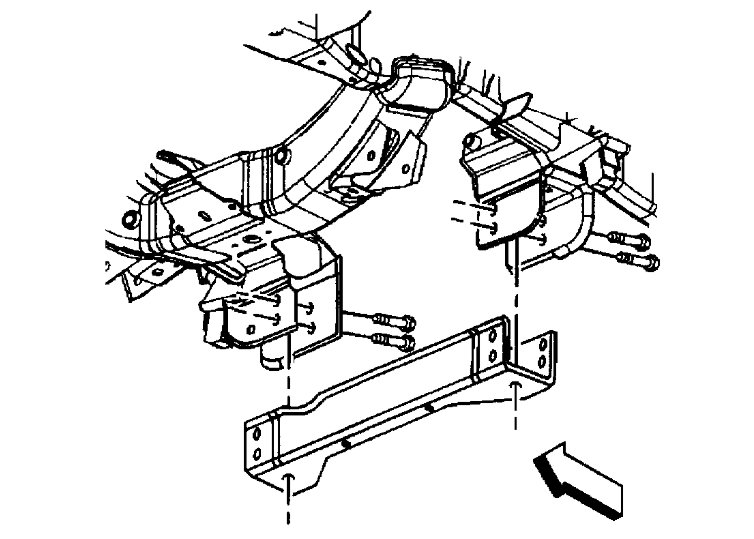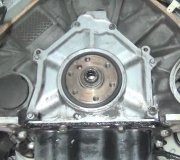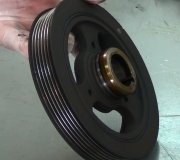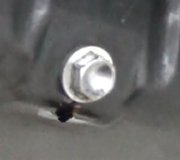Removal Procedure
Fig. 175: View Of Inner Axle Housing Nuts
1. If equipped with four wheel drive (4WD), remove the inner axle housing nuts and washers
from the bracket.
2. Support the front drive axle with a suitable jack.
Fig. 176: View Of Differential Carrier Lower Mounting Bolt
3. If equipped with 4WD, remove the differential carrier lower mounting bolt and nut.
Fig. 177: View Of Differential Carrier Upper Mounting Bolt
4. If equipped with 4WD, remove the differential carrier upper mounting bolt and nut.
5. Lower the front drive axle.
Fig. 178: View Of Transmission Cover Bolt
6. Remove the transmission cover bolts.
Fig. 179: Identifying Oil Pan Skid Plate
7. If equipped, remove the oil pan skid plate bolts.
8. Remove the oil pan skid plate.
Fig. 180: View Of Crossbar Bolts & Bar (2WD)
9. Remove the crossbar bolts.
10. Remove the crossbar.
Fig. 181: View Of Left Closeout Cover & Bolt
11. Remove the transmission cover bolt and cover.
12. Drain the engine oil and remove the engine oil filter.
13. Re-install the drain plug and oil filter until snug.
Fig. 182: Identifying Stud & Bolt Securing Transmission To Engine (Right Side)
14. If equipped with the 4L60-E automatic transmission, remove the transmission bolt and stud on
the right side.
Fig. 183: Identifying Six Studs & One Bolt Securing Transmission To Engine
15. Remove the bottom bolt on the left side.
Fig. 184: View Of Transmission Converter Cover Bolt (4L80-E)
16. If equipped with the 4L80-E automatic transmission, remove the transmission converter cover
bolts.
Fig. 185: Stud And Bolt Securing The Transmission To The Engine
17. If equipped with a manual transmission, remove the two bottom bellhousing bolts.
Fig. 186: Identifying Electrical Connector (Right Side Of Engine)
18. Disconnect the oil level sensor electrical connector (6).
Fig. 187: View Of Positive Battery Cable, Channel & Bolt
19. Remove the battery cable channel bolt.
20. Slide the channel pin out of the oil pan tab.
Fig. 188: View Of Positive Battery Cable Clip & Bolt
21. Remove the positive battery cable clip bolt and clip.
Fig. 189: Oil Pan & Bolts
22. Remove the oil pan bolts.
23. Remove the oil pan.
Fig. 190: Oil Pan Gasket Retaining Rivets
24. Drill (3) out the oil pan gasket retaining rivets (2), if required.
25. Remove the gasket (1) from the pan.
IMPORTANT: DO NOT allow foreign material to enter the oil passages of the oil
pan, cap or cover the openings as required.
26. Discard the gasket and rivets.
27. Clean and inspect the engine oil pan.
Installation Procedure
Fig. 191: View Of Sealant Applied To Front Oil Pan-To-Engine Block Junction
1. Apply a 5 mm (0.20 in) bead of sealant GM P/N United States 12378190, or equivalent 20 mm
(0.80 in) long to the engine block. Apply the sealant directly onto the tabs of the front cover
gasket that protrudes into the oil pan surface.
Fig. 192: View Of Sealant Applied To Rear Oil Pan-To-Engine Block Junction
2. Apply a 5 mm (0.20 in) bead of sealant GM P/N United States 12378190, or equivalent 20 mm
(0.8 in) long to the engine block. Apply the sealant directly onto the tabs of the rear cover
gasket that protrudes into the oil pan surface.
Fig. 193: Oil Pan & Bolts
3. Pre-assemble the oil pan gasket to the pan.
? Install the gasket onto the pan.
? Install the oil pan bolts to the pan and through the gasket.
4. Install the oil pan, gasket and bolts to the engine block.
5. Tighten the oil pan bolts until snug. Do not overtighten.
Fig. 194: Manual Transmission Bellhousing Bolts
6. Install the two bottom bellhousing bolts until snug, if equipped with a manual transmission.
IMPORTANT:
? The alignment of the structural oil pan is critical. The rear bolt
hole locations of the oil pan provide mounting points for the
transmission bellhousing. To ensure the rigidity of the
powertrain and correct transmission alignment, it is important
that the rear of the block and the rear of the oil pan must NEVER
protrude beyond the engine block and transmission bellhousing
plane.
? Do not reuse the oil pan gasket.
? It is not necessary to rivet the NEW gasket to the oil pan.
IMPORTANT: Be sure to align the oil gallery passages in the oil pan and engine
block properly with the oil pan gasket.
Fig. 195: View Of Transmission Converter Cover Bolt (4L80-E)
7. Install the transmission converter cover bolts until snug, if equipped with the 4L80-E automatic
transmission.
Fig. 196: Identifying Stud & Bolt Securing Transmission To Engine (Right Side)
8. Install the transmission bolt and stud on the right side until snug, If equipped with the 4L60-E
automatic transmission.
Fig. 197: Identifying Six Studs & One Bolt Securing Transmission To Engine
9. Install the bottom bolt on the left side until snug.
Tighten:
1. Tighten the oil pan, and oil pan-to-front cover bolts to 25 N.M (18 lb ft).
2. Tighten the oil pan-to-rear cover bolts to 12 N.M (106 lb in).
3. Tighten the bellhousing, converter cover, and transmission bolts/stud to 50 N.M (37 lb
ft).
Fig. 198: View Of Positive Battery Cable Clip & Bolt
10. Install the positive battery cable clip and bolt to the oil pan.
Tighten: Tighten the positive battery cable clip bolt to 9 N.M (80 lb in).
Fig. 199: View Of Positive Battery Cable, Channel & Bolt
11. Slide the channel pin in to the oil pan tab.
12. Install the battery cable channel bolt.
Tighten: Tighten the battery cable channel bolt to 12 N.M (106 lb in).
Fig. 200: Identifying Electrical Connector (Right Side Of Engine)
13. Connect the oil level sensor electrical connector (6).
Fig. 201: View Of Left Closeout Cover & Bolt
14. Install the transmission cover and bolt.
NOTE:
Refer to Fastener Notice in Cautions and Notices.
Tighten: Tighten the transmission cover bolt to 12 N.M (106 lb in).
Fig. 202: View Of Crossbar Bolts & Bar (2WD)
15. Install the crossbar.
16. Install the crossbar bolts.
Tighten: Tighten the crossbar bolts to 100 N.M (74 lb ft).
Fig. 203: Identifying Oil Pan Skid Plate
17. If equipped, install the oil pan skid plate.
18. Install the oil pan skid plate bolts.
Tighten: Tighten the oil pan skid plate bolts to 20 N.M (15 lb ft).
Fig. 204: View Of Transmission Cover Bolt
19. Install the transmission cover bolts.
Tighten: Tighten the transmission cover bolt to 12 N.M (106 lb in).
Fig. 205: View Of Differential Carrier Upper Mounting Bolt
20. Raise the front drive axle into position.
21. If equipped with 4WD, install the differential carrier upper mounting bolt and nut until snug.
Do not tighten at this time.
Fig. 206: View Of Differential Carrier Lower Mounting Bolt
22. If equipped with 4WD, install the differential carrier lower mounting bolt and nut.
Tighten: Tighten the bolts to 100 N.M (75 lb ft).
Fig. 207: View Of Inner Axle Housing Nuts
23. If equipped with 4WD, install the inner axle housing nuts and washers to the bracket.
Tighten: Tighten the nuts to 100 N.M (75 lb ft).
24. Remove the jack from the front drive axle.
25. Install new engine oil and a new oil filter. Refer to Engine Oil and Oil Filter Replacement. Courtesy of GENERAL MOTORS CORP.
SPONSORED LINKS
Saturday, December 12th, 2020 AT 9:15 AM
(Merged)




